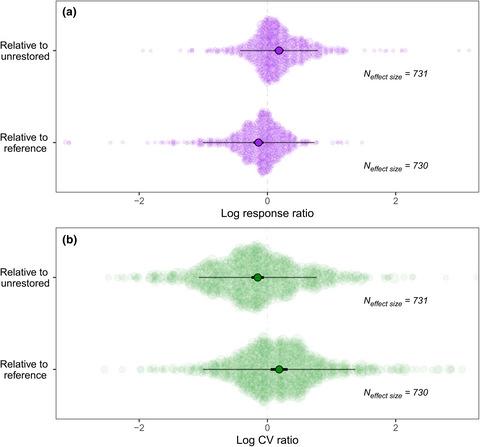当前位置:
X-MOL 学术
›
Ecol. Lett.
›
论文详情
Our official English website, www.x-mol.net, welcomes your
feedback! (Note: you will need to create a separate account there.)
Terrestrial ecosystem restoration increases biodiversity and reduces its variability, but not to reference levels: A global meta-analysis
Ecology Letters ( IF 7.6 ) Pub Date : 2022-05-12 , DOI: 10.1111/ele.14025 Joe Atkinson 1 , Lars A Brudvig 2 , Max Mallen-Cooper 1 , Shinichi Nakagawa 1 , Angela T Moles 1 , Stephen P Bonser 1
Ecology Letters ( IF 7.6 ) Pub Date : 2022-05-12 , DOI: 10.1111/ele.14025 Joe Atkinson 1 , Lars A Brudvig 2 , Max Mallen-Cooper 1 , Shinichi Nakagawa 1 , Angela T Moles 1 , Stephen P Bonser 1
Affiliation

|
Ecological restoration projects often have variable and unpredictable outcomes, and these can limit the overall impact on biodiversity. Previous syntheses have investigated restoration effectiveness by comparing average restored conditions to average conditions in unrestored or reference systems. Here, we provide the first quantification of the extent to which restoration affects both the mean and variability of biodiversity outcomes, through a global meta-analysis of 83 terrestrial restoration studies. We found that, relative to unrestored (degraded) sites, restoration actions increased biodiversity by an average of 20%, while decreasing the variability of biodiversity (quantified by the coefficient of variation) by an average of 14%. As restorations aged, mean biodiversity increased and variability decreased relative to unrestored sites. However, restoration sites remained, on average, 13% below the biodiversity of reference (target) ecosystems, and were characterised by higher (20%) variability. The lower mean and higher variability in biodiversity at restored sites relative to reference sites remained consistent over time, suggesting that sources of variation (e.g. prior land use, restoration practices) have an enduring influence on restoration outcomes. Our results point to the need for new research confronting the causes of variability in restoration outcomes, and close variability and biodiversity gaps between restored and reference conditions.
中文翻译:

陆地生态系统恢复增加生物多样性并减少其变异性,但未达到参考水平:全球荟萃分析
生态恢复项目通常会产生多变且不可预测的结果,这些可能会限制对生物多样性的整体影响。以前的综合通过将平均恢复条件与未恢复或参考系统中的平均条件进行比较来研究恢复效果。在这里,我们通过对 83 项陆地恢复研究的全球荟萃分析,首次量化了恢复对生物多样性结果的平均值和可变性的影响程度。我们发现,相对于未恢复(退化)的场地,恢复行动平均增加了 20% 的生物多样性,同时平均减少了 14% 的生物多样性变异性(由变异系数量化)。随着恢复的老化,相对于未恢复的地点,平均生物多样性增加,变异性降低。然而,平均而言,恢复地点的生物多样性比参考(目标)生态系统的生物多样性低 13%,并且具有更高(20%)的可变性。随着时间的推移,恢复地点相对于参考地点的生物多样性较低的平均值和较高的变异性保持一致,这表明变异来源(例如先前的土地利用、恢复实践)对恢复结果具有持久的影响。我们的研究结果表明,需要进行新的研究来应对恢复结果可变性的原因,以及缩小恢复条件和参考条件之间的可变性和生物多样性差距。随着时间的推移,恢复地点相对于参考地点的生物多样性较低的平均值和较高的变异性保持一致,这表明变异来源(例如先前的土地利用、恢复实践)对恢复结果具有持久的影响。我们的研究结果表明,需要进行新的研究来应对恢复结果可变性的原因,以及缩小恢复条件和参考条件之间的可变性和生物多样性差距。随着时间的推移,恢复地点相对于参考地点的生物多样性较低的平均值和较高的变异性保持一致,这表明变异来源(例如先前的土地利用、恢复实践)对恢复结果具有持久的影响。我们的研究结果表明,需要进行新的研究来解决恢复结果可变性的原因,以及缩小恢复条件和参考条件之间的可变性和生物多样性差距。
更新日期:2022-05-12
中文翻译:

陆地生态系统恢复增加生物多样性并减少其变异性,但未达到参考水平:全球荟萃分析
生态恢复项目通常会产生多变且不可预测的结果,这些可能会限制对生物多样性的整体影响。以前的综合通过将平均恢复条件与未恢复或参考系统中的平均条件进行比较来研究恢复效果。在这里,我们通过对 83 项陆地恢复研究的全球荟萃分析,首次量化了恢复对生物多样性结果的平均值和可变性的影响程度。我们发现,相对于未恢复(退化)的场地,恢复行动平均增加了 20% 的生物多样性,同时平均减少了 14% 的生物多样性变异性(由变异系数量化)。随着恢复的老化,相对于未恢复的地点,平均生物多样性增加,变异性降低。然而,平均而言,恢复地点的生物多样性比参考(目标)生态系统的生物多样性低 13%,并且具有更高(20%)的可变性。随着时间的推移,恢复地点相对于参考地点的生物多样性较低的平均值和较高的变异性保持一致,这表明变异来源(例如先前的土地利用、恢复实践)对恢复结果具有持久的影响。我们的研究结果表明,需要进行新的研究来应对恢复结果可变性的原因,以及缩小恢复条件和参考条件之间的可变性和生物多样性差距。随着时间的推移,恢复地点相对于参考地点的生物多样性较低的平均值和较高的变异性保持一致,这表明变异来源(例如先前的土地利用、恢复实践)对恢复结果具有持久的影响。我们的研究结果表明,需要进行新的研究来应对恢复结果可变性的原因,以及缩小恢复条件和参考条件之间的可变性和生物多样性差距。随着时间的推移,恢复地点相对于参考地点的生物多样性较低的平均值和较高的变异性保持一致,这表明变异来源(例如先前的土地利用、恢复实践)对恢复结果具有持久的影响。我们的研究结果表明,需要进行新的研究来解决恢复结果可变性的原因,以及缩小恢复条件和参考条件之间的可变性和生物多样性差距。











































 京公网安备 11010802027423号
京公网安备 11010802027423号